Attractions · Europe · Featured · Food and Drink · Going Out · Italy · Regions · Road Travel · Speciality Travel · Travel Miscellany · Western Europe
Delicious drives in Italy: Milan to Scanzorosciate
This is the first of a series of three posts showcasing five secret foodie locations in the Bergamo province all easy to reach from Milan and Bergamo, provided you have a car! Weve teamed up with Hertz for the Delicious Drives project and got a shiny new Fiat 500, the ideal car to drive down up the mountains and down the tiny village backroads, yet spacious enough for all our food purchases!
Pagnoncelli Folcieri was the first stop on our foodie road trip in the Bergamo province, in collaboration with Hertz. The idea was covering 5 off the beaten track foodie locations, over a two-day period navigated using our lovely car hire.
 The Pagnoncelli Folcieri winery may indeed be close to the city, but public transport is unreliable so our Fiat 500 was ideal to navigate Scanzorosciates narrow streets leading to the vineyard. We picked our car up from Linate airport, and less than an hour later we were sitting in the fresco-covered room with Francesca, ready to learn all about this unique wine.
The Pagnoncelli Folcieri winery may indeed be close to the city, but public transport is unreliable so our Fiat 500 was ideal to navigate Scanzorosciates narrow streets leading to the vineyard. We picked our car up from Linate airport, and less than an hour later we were sitting in the fresco-covered room with Francesca, ready to learn all about this unique wine.
 ‘My family has been making wine here since 1852 said Francesca Pagnoncelli Longer than Italy exists, in fact.
My husband and I were sitting in the degustation room of the Pagnoncelli Folcieri winery, makers of the unique Moscato di Scanzo wine.
Pagnoncelli Folcieri is one of the only 20 producers of Moscato di Scanzo, the smallest DOP in Italy. DOP means Protected Denomination of Origin, the highest tier of Italian wine classifications. Each winery only produces 800 Moscato bottles every year as you can imagine, the wine is very, very precious.
‘My family has been making wine here since 1852 said Francesca Pagnoncelli Longer than Italy exists, in fact.
My husband and I were sitting in the degustation room of the Pagnoncelli Folcieri winery, makers of the unique Moscato di Scanzo wine.
Pagnoncelli Folcieri is one of the only 20 producers of Moscato di Scanzo, the smallest DOP in Italy. DOP means Protected Denomination of Origin, the highest tier of Italian wine classifications. Each winery only produces 800 Moscato bottles every year as you can imagine, the wine is very, very precious.
 Moscato di Scanzo has a very long history as Francesca said, it was always known that wine was being made in the region, but no one knew exactly how it was, or why it was so special. Some reports claim that Moscato di Scanzo was already popular in the courts of Europe in the 18th century, and it was one of the favourite wines of Catherine II of Russia.
Moscato di Scanzo as we know it today was born only after WW2, and it is governed by a strict production protocol. Harvest is in late October, to increase sugar content. After picking, the grapes are sorted bunches are hand-checked, one by one, and every single grape that doesnt make the cut is removed, for instance when grapes are too ripe, not ripe enough or damaged. Sorting takes weeks of full-time work. Once the grapes are all sorted, they are laid out to dry on lattices, where theyre left for a further three weeks, until they lose approximately 70 per cent of their original volume. Finally, the grapes are pressed and left to ferment in stainless steel tanks for a minimum of 2 years, even though most producers leave it for longer. For instance, in 2017 Francesca was selling Moscato made in 2013.
Moscato di Scanzo has a very long history as Francesca said, it was always known that wine was being made in the region, but no one knew exactly how it was, or why it was so special. Some reports claim that Moscato di Scanzo was already popular in the courts of Europe in the 18th century, and it was one of the favourite wines of Catherine II of Russia.
Moscato di Scanzo as we know it today was born only after WW2, and it is governed by a strict production protocol. Harvest is in late October, to increase sugar content. After picking, the grapes are sorted bunches are hand-checked, one by one, and every single grape that doesnt make the cut is removed, for instance when grapes are too ripe, not ripe enough or damaged. Sorting takes weeks of full-time work. Once the grapes are all sorted, they are laid out to dry on lattices, where theyre left for a further three weeks, until they lose approximately 70 per cent of their original volume. Finally, the grapes are pressed and left to ferment in stainless steel tanks for a minimum of 2 years, even though most producers leave it for longer. For instance, in 2017 Francesca was selling Moscato made in 2013.
 After our tour around the vineyard where Francesca and her husband do all the work by hand, we headed back into the degustation room to sample the wine. Francesca likes pouring Moscato into cognac glasses to better release the aroma and believes that the wine is best consumed alone, with no food pairing. Its a meditation wine, a wine that invites contemplation, to be enjoyed after a meal, in good company and surrounded by beauty, she explained. I swirled my glass in the light of a sunbeam running across the table. The wine was deep ruby, with dark purple tones and reflections the colour of burnt earth. I lifted the glass to my nose and took a whiff.
After our tour around the vineyard where Francesca and her husband do all the work by hand, we headed back into the degustation room to sample the wine. Francesca likes pouring Moscato into cognac glasses to better release the aroma and believes that the wine is best consumed alone, with no food pairing. Its a meditation wine, a wine that invites contemplation, to be enjoyed after a meal, in good company and surrounded by beauty, she explained. I swirled my glass in the light of a sunbeam running across the table. The wine was deep ruby, with dark purple tones and reflections the colour of burnt earth. I lifted the glass to my nose and took a whiff.
 What can you smell? Francesca asked. Normally, I can only come up with the usual answers berries, cherry and the like. But Moscato di Scanzo was deeper, more complex and layered than any wine I had ever had. I could smell rain and wet leaves, bourbon vanilla and rosehip, prune and tobacco. Tentatively, I took a sip, and flavours multiplied so fast that I had a hard time naming them all. There was frankincense yes, the smell of church! Francesca said there was marasca, an Italian kind of sour cherry, hibiscus, black pepper and dark chocolate, and many more. It was like walking into a perfumery and being surrounded by a myriad of captivating scents, so intense you have a hard time separating them all, scents staying with you even after youve left. Moscato lingers in your mouth its one of the wines with the most intense caudalie, the unit that measures the persistency of flavours.
What can you smell? Francesca asked. Normally, I can only come up with the usual answers berries, cherry and the like. But Moscato di Scanzo was deeper, more complex and layered than any wine I had ever had. I could smell rain and wet leaves, bourbon vanilla and rosehip, prune and tobacco. Tentatively, I took a sip, and flavours multiplied so fast that I had a hard time naming them all. There was frankincense yes, the smell of church! Francesca said there was marasca, an Italian kind of sour cherry, hibiscus, black pepper and dark chocolate, and many more. It was like walking into a perfumery and being surrounded by a myriad of captivating scents, so intense you have a hard time separating them all, scents staying with you even after youve left. Moscato lingers in your mouth its one of the wines with the most intense caudalie, the unit that measures the persistency of flavours.
 It was then that I understood what Francesca meant by meditation wine. Sampling Moscato is a sensory experience so strong it makes you want to pause and listen for every sip is the result of decades of family history and months of painstaking work, pruning, pushing wheelbarrows, harvesting and sorting. A wine that speaks of the land, and of the family that is custodian of its secret.
It was then that I understood what Francesca meant by meditation wine. Sampling Moscato is a sensory experience so strong it makes you want to pause and listen for every sip is the result of decades of family history and months of painstaking work, pruning, pushing wheelbarrows, harvesting and sorting. A wine that speaks of the land, and of the family that is custodian of its secret.
 Disclosure: This post is sponsored by Hertz.
Disclosure: This post is sponsored by Hertz.
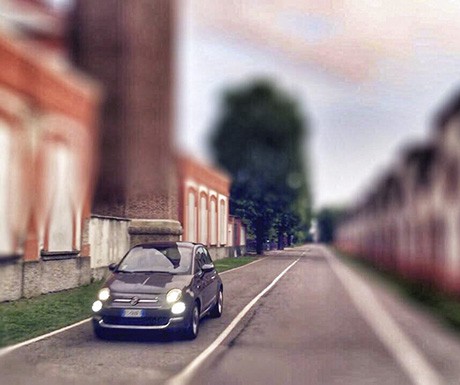 The Pagnoncelli Folcieri winery may indeed be close to the city, but public transport is unreliable so our Fiat 500 was ideal to navigate Scanzorosciates narrow streets leading to the vineyard. We picked our car up from Linate airport, and less than an hour later we were sitting in the fresco-covered room with Francesca, ready to learn all about this unique wine.
The Pagnoncelli Folcieri winery may indeed be close to the city, but public transport is unreliable so our Fiat 500 was ideal to navigate Scanzorosciates narrow streets leading to the vineyard. We picked our car up from Linate airport, and less than an hour later we were sitting in the fresco-covered room with Francesca, ready to learn all about this unique wine.
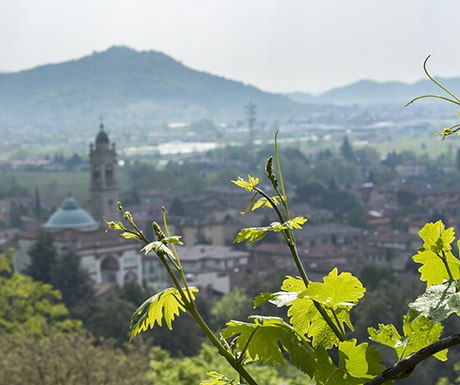 ‘My family has been making wine here since 1852 said Francesca Pagnoncelli Longer than Italy exists, in fact.
My husband and I were sitting in the degustation room of the Pagnoncelli Folcieri winery, makers of the unique Moscato di Scanzo wine.
Pagnoncelli Folcieri is one of the only 20 producers of Moscato di Scanzo, the smallest DOP in Italy. DOP means Protected Denomination of Origin, the highest tier of Italian wine classifications. Each winery only produces 800 Moscato bottles every year as you can imagine, the wine is very, very precious.
‘My family has been making wine here since 1852 said Francesca Pagnoncelli Longer than Italy exists, in fact.
My husband and I were sitting in the degustation room of the Pagnoncelli Folcieri winery, makers of the unique Moscato di Scanzo wine.
Pagnoncelli Folcieri is one of the only 20 producers of Moscato di Scanzo, the smallest DOP in Italy. DOP means Protected Denomination of Origin, the highest tier of Italian wine classifications. Each winery only produces 800 Moscato bottles every year as you can imagine, the wine is very, very precious.
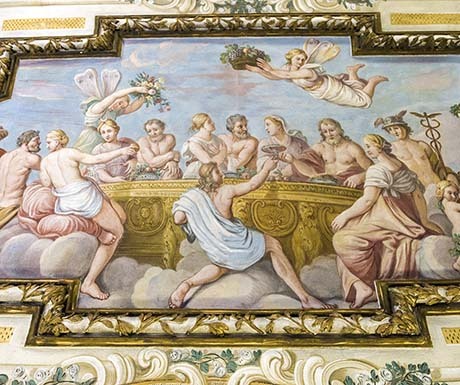 Moscato di Scanzo has a very long history as Francesca said, it was always known that wine was being made in the region, but no one knew exactly how it was, or why it was so special. Some reports claim that Moscato di Scanzo was already popular in the courts of Europe in the 18th century, and it was one of the favourite wines of Catherine II of Russia.
Moscato di Scanzo as we know it today was born only after WW2, and it is governed by a strict production protocol. Harvest is in late October, to increase sugar content. After picking, the grapes are sorted bunches are hand-checked, one by one, and every single grape that doesnt make the cut is removed, for instance when grapes are too ripe, not ripe enough or damaged. Sorting takes weeks of full-time work. Once the grapes are all sorted, they are laid out to dry on lattices, where theyre left for a further three weeks, until they lose approximately 70 per cent of their original volume. Finally, the grapes are pressed and left to ferment in stainless steel tanks for a minimum of 2 years, even though most producers leave it for longer. For instance, in 2017 Francesca was selling Moscato made in 2013.
Moscato di Scanzo has a very long history as Francesca said, it was always known that wine was being made in the region, but no one knew exactly how it was, or why it was so special. Some reports claim that Moscato di Scanzo was already popular in the courts of Europe in the 18th century, and it was one of the favourite wines of Catherine II of Russia.
Moscato di Scanzo as we know it today was born only after WW2, and it is governed by a strict production protocol. Harvest is in late October, to increase sugar content. After picking, the grapes are sorted bunches are hand-checked, one by one, and every single grape that doesnt make the cut is removed, for instance when grapes are too ripe, not ripe enough or damaged. Sorting takes weeks of full-time work. Once the grapes are all sorted, they are laid out to dry on lattices, where theyre left for a further three weeks, until they lose approximately 70 per cent of their original volume. Finally, the grapes are pressed and left to ferment in stainless steel tanks for a minimum of 2 years, even though most producers leave it for longer. For instance, in 2017 Francesca was selling Moscato made in 2013.
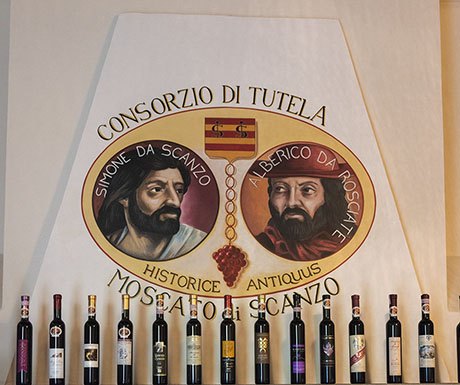 After our tour around the vineyard where Francesca and her husband do all the work by hand, we headed back into the degustation room to sample the wine. Francesca likes pouring Moscato into cognac glasses to better release the aroma and believes that the wine is best consumed alone, with no food pairing. Its a meditation wine, a wine that invites contemplation, to be enjoyed after a meal, in good company and surrounded by beauty, she explained. I swirled my glass in the light of a sunbeam running across the table. The wine was deep ruby, with dark purple tones and reflections the colour of burnt earth. I lifted the glass to my nose and took a whiff.
After our tour around the vineyard where Francesca and her husband do all the work by hand, we headed back into the degustation room to sample the wine. Francesca likes pouring Moscato into cognac glasses to better release the aroma and believes that the wine is best consumed alone, with no food pairing. Its a meditation wine, a wine that invites contemplation, to be enjoyed after a meal, in good company and surrounded by beauty, she explained. I swirled my glass in the light of a sunbeam running across the table. The wine was deep ruby, with dark purple tones and reflections the colour of burnt earth. I lifted the glass to my nose and took a whiff.
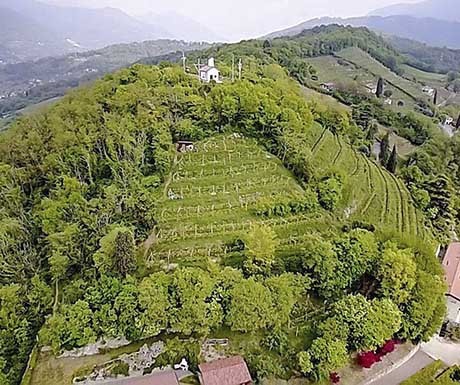 What can you smell? Francesca asked. Normally, I can only come up with the usual answers berries, cherry and the like. But Moscato di Scanzo was deeper, more complex and layered than any wine I had ever had. I could smell rain and wet leaves, bourbon vanilla and rosehip, prune and tobacco. Tentatively, I took a sip, and flavours multiplied so fast that I had a hard time naming them all. There was frankincense yes, the smell of church! Francesca said there was marasca, an Italian kind of sour cherry, hibiscus, black pepper and dark chocolate, and many more. It was like walking into a perfumery and being surrounded by a myriad of captivating scents, so intense you have a hard time separating them all, scents staying with you even after youve left. Moscato lingers in your mouth its one of the wines with the most intense caudalie, the unit that measures the persistency of flavours.
What can you smell? Francesca asked. Normally, I can only come up with the usual answers berries, cherry and the like. But Moscato di Scanzo was deeper, more complex and layered than any wine I had ever had. I could smell rain and wet leaves, bourbon vanilla and rosehip, prune and tobacco. Tentatively, I took a sip, and flavours multiplied so fast that I had a hard time naming them all. There was frankincense yes, the smell of church! Francesca said there was marasca, an Italian kind of sour cherry, hibiscus, black pepper and dark chocolate, and many more. It was like walking into a perfumery and being surrounded by a myriad of captivating scents, so intense you have a hard time separating them all, scents staying with you even after youve left. Moscato lingers in your mouth its one of the wines with the most intense caudalie, the unit that measures the persistency of flavours.
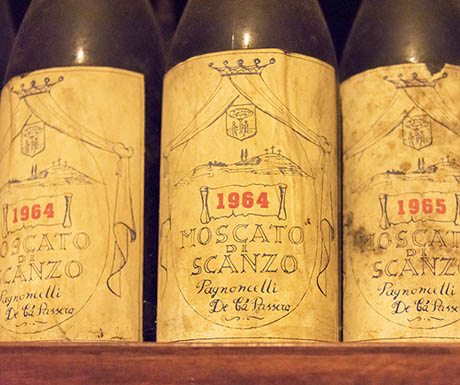 It was then that I understood what Francesca meant by meditation wine. Sampling Moscato is a sensory experience so strong it makes you want to pause and listen for every sip is the result of decades of family history and months of painstaking work, pruning, pushing wheelbarrows, harvesting and sorting. A wine that speaks of the land, and of the family that is custodian of its secret.
It was then that I understood what Francesca meant by meditation wine. Sampling Moscato is a sensory experience so strong it makes you want to pause and listen for every sip is the result of decades of family history and months of painstaking work, pruning, pushing wheelbarrows, harvesting and sorting. A wine that speaks of the land, and of the family that is custodian of its secret.

Did you enjoy this article?
Receive similar content direct to your inbox.

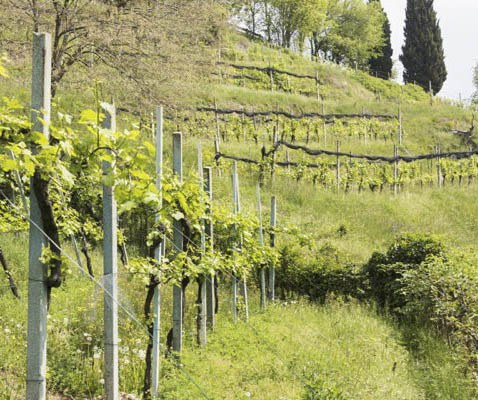

What a fantastic trip! I love Moscato, so I’d love to visit here. I love how much is possible within a day trip of most Italian cities and I can’t wait to go back to Italy this summer. Saved!